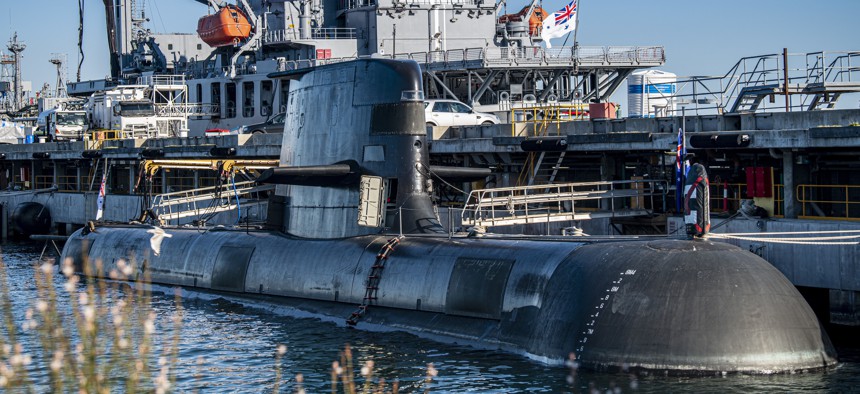
A Collins-class guided missile submarine is moored at Royal Australian Navy base HMAS Stirling, Australia. U.S. Navy / Mass Communication Specialist 2nd Class Jeanette Mullinax
Australia Will Get Nuclear-Powered Subs In New Partnership With US, UK
Dubbed AUKUS, the new security partnership will increase focus on the Indo-Pacific.
Updated to add Biden remarks at 5:32 p.m. ET.
Australia will get its first nuclear-powered submarines under a new trilateral relationship with the United States and United Kingdom intended to improve security in the Pacific, President Joe Biden announced Wednesday.
The move will put nuclear-powered submarines, which have longer range than Australia’s current conventional subs and can stay underwater for months, in China’s backyard as the administration seeks to pivot its foreign policy to the Indo-Pacific region.
“This is about investing in our greatest source of strength—our alliances—and updating them to better meet the threats of today and tomorrow,” Biden said at the White House, flanked virtually by leaders from the United Kingdom and Australia. “This initiative is about making sure that each of us has a modern capability, the most modern capability we need to maneuver and defend against rapidly evolving threats.”
A senior administration official expanded a bit on the idea.
“We undertake this effort as part of a larger constellation of steps including stronger bilateral partnerships with our traditional security partners in Asia...and also stronger engagement with new partners like India, Vietnam, and new formations like the Quad,” the official said.
Sen. Ben Sasse, R-Neb., applauded the deal, saying that it is a “concrete” step to counter Beijing.
“Partnering with Australia on a new nuclear-powered submarine fleet is a huge investment in the long-term health of our alliances and sends a clear message of strength to Chairman Xi,” Sasse said in a statement. “The President’s Asia team deserves credit for jumpstarting this important work — but we still need more urgency.”Chinese officials have yet to respond to the news. The increased presence of more capable submarines in the Pacific could be viewed by Beijing as a threat, but Narang pointed out that there are already American nuclear submarines patrolling in the Pacific and the South China Sea, which could soften China’s reaction. It will also likely take years before the submarines are actually in the water with trained crews onboard, which gives China a long time to respond and prepare if needed.
China has a fleet of 60 submarines, including six nuclear-powered attack subs, according to a Nuclear Threat Initiative report from February.
Asked if this is a military move aimed at China, the senior administration official stressed that “this partnership is not aimed [at] or about any one country. It’s about advancing our strategic interests, upholding the international rules based order and promoting peace and stability in the Indo-Pacific.”
More broadly, the new trilateral partnership, which will be known by the acronym AUKUS, will include increased cooperation on cybersecurity and artificial intelligence, as well as more integration of industrial bases and supply chains, the senior administration official said.
But the group’s first priority will be sharing technology with Australia to help it develop and field nuclear-powered submarines, the senior official said. This is only the second time the United States has shared this type of sensitive technology with an ally. The first was with the United Kingdom in 1958.
“This is a fundamental decision that binds decisively Australia to the United States and Great Britain for generations,” the official said.
Officials from the three countries will begin an 18-month consultation period during which they will determine details about things such as the workforce, training requirements, production timelines, nuclear nonproliferation and safety, Biden said. The effort will be led by Defense Secretary Lloyd Austin in consultation with officials from the Energy Department and State Department.
The partnership will include only nuclear propulsion, and Australia has no intention of acquiring nuclear weapons or a civil nuclear capability, Australian Prime Minister Scott Morrison said.
Some nuclear experts raised concerns about any proliferation of nuclear technology. James Acton, co-director of the Carnegie Endowment for International Peace’s Nuclear Policy Program, called it a “mistake” and worried that the partnership would establish a dangerous precedent that could make nuclear material more widespread around the globe.
“If the US and UK help Australia acquire nuclear submarines, will they say no to, for example, South Korea, whose nonproliferation credentials are less than perfect (sorry) and which has stronger potential incentives to proliferate?” Acton wrote on Twitter.
Others disagree, saying that Australia is not a proliferation risk. Vipin Narang, a professor of nuclear security and political science at the Massachusetts Institute of Technology, argued that, because Australia is so far south with so much ocean to patrol, the benefits of the increased range offered by a nuclear-powered submarine outweigh the potential risks,
“If there’s any country I trust, it’s really Australia,” Narang said. “I know there are proliferation risks, but to me they’re offset by the warm fuzzy feeling I get from Australia having SSNs to help us out.”
The senior administration official pushed back on the idea that this could spark nuclear proliferation.
“This technology is extremely sensitive. This is frankly an exception to our policy in many respects,” the official said. “We view this as a one-off.”
One open question is whether the Australian subs will be powered by highly enriched uranium, a weapons-grade power source that fuels both American and British submarines, or low enriched uranium, which powers the French nuclear navy and can not be used directly for bombs, said Kingston Reif, the director of disarmament and threat reduction policy at the Arms Control Association. Using low-enriched uranium could help calm fears about nuclear proliferation, Reif said.
The United States is also expected to run out of the highly enriched uranium that powers its subs and aircraft carriers by 2060, and it’s unclear how giving fuel to Australia might affect that supply, Reif said.
Australia, which is planning to refurbish its six conventionally powered Collins-class guided-missile submarines, had also intended to buy another 12 conventional subs designed by French shipbuilder Naval Group. The first ship in the $90 billion program was expected to be delivered in the early 2030s. That program will reportedly be canceled so that Australia can pursue acquisition of nuclear subs instead.
